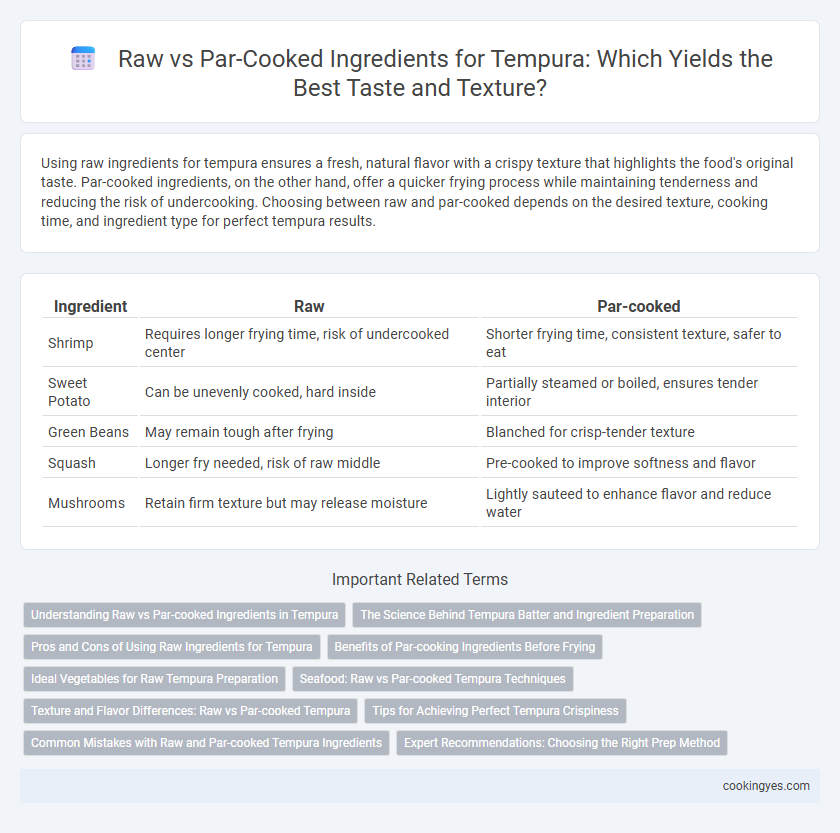Using raw ingredients for tempura ensures a fresh, natural flavor with a crispy texture that highlights the food's original taste. Par-cooked ingredients, on the other hand, offer a quicker frying process while maintaining tenderness and reducing the risk of undercooking. Choosing between raw and par-cooked depends on the desired texture, cooking time, and ingredient type for perfect tempura results.
Table of Comparison
| Ingredient | Raw | Par-cooked |
|---|---|---|
| Shrimp | Requires longer frying time, risk of undercooked center | Shorter frying time, consistent texture, safer to eat |
| Sweet Potato | Can be unevenly cooked, hard inside | Partially steamed or boiled, ensures tender interior |
| Green Beans | May remain tough after frying | Blanched for crisp-tender texture |
| Squash | Longer fry needed, risk of raw middle | Pre-cooked to improve softness and flavor |
| Mushrooms | Retain firm texture but may release moisture | Lightly sauteed to enhance flavor and reduce water |
Understanding Raw vs Par-cooked Ingredients in Tempura
Understanding raw vs par-cooked ingredients in tempura is essential for achieving the perfect texture and flavor balance. Raw ingredients like shrimp or fresh vegetables retain their natural moisture and tenderness, while par-cooked items such as root vegetables benefit from partial cooking to ensure even frying and avoid undercooked centers. Selecting the appropriate preparation method enhances the tempura's crispiness and prevents sogginess, delivering an authentic and satisfying culinary experience.
The Science Behind Tempura Batter and Ingredient Preparation
Tempura batter relies on cold water and minimal mixing to create a light, crispy texture by preventing gluten formation in the flour. Using raw ingredients ensures a crisp exterior while maintaining moisture inside, as the hot oil rapidly cooks the batter and food simultaneously. Par-cooked items reduce frying time but can result in less optimal texture due to premature moisture loss, affecting the final crunch and flavor balance.
Pros and Cons of Using Raw Ingredients for Tempura
Using raw ingredients in tempura ensures maximum freshness and preserves natural flavors and textures, contributing to a crisp and vibrant final dish. However, raw components often demand precise frying times and temperatures to avoid undercooking or uneven texture, increasing the risk of sogginess or raw centers. This method can also require more preparation time and skill to maintain moisture balance and achieve the ideal tempura crispiness.
Benefits of Par-cooking Ingredients Before Frying
Par-cooking ingredients before frying tempura enhances texture by ensuring even cooking and preventing undercooked centers. It reduces frying time, which minimizes oil absorption and results in a lighter, crispier batter. This method preserves the fresh flavor and vibrant color of vegetables, creating a superior tempura experience.
Ideal Vegetables for Raw Tempura Preparation
Ideal vegetables for raw tempura preparation include asparagus, sweet potatoes, green beans, and bell peppers due to their firm texture and ability to retain moisture during frying. These vegetables maintain a crisp exterior and tender interior when battered and fried directly from raw, enhancing the tempura's signature lightness. Choosing vegetables with low water content prevents sogginess and ensures optimal crunchiness in the finished tempura dish.
Seafood: Raw vs Par-cooked Tempura Techniques
Seafood tempura requires precise handling of raw versus par-cooked ingredients to achieve optimal texture and flavor. Raw seafood, such as shrimp and white fish, benefits from a quick dip in batter and frying at high heat to lock in moisture and create a crispy exterior. Par-cooked seafood, like scallops or octopus, should be partially boiled or steamed before frying to ensure tenderness while preventing overcooking during the tempura process.
Texture and Flavor Differences: Raw vs Par-cooked Tempura
Raw ingredients in tempura result in a lighter, crispier texture with a fresh, natural flavor, highlighting the ingredient's original taste and moisture. Par-cooked ingredients offer a softer interior while maintaining a crispy batter, enhancing flavor depth through slight caramelization or seasoning absorbed during pre-cooking. Choosing between raw and par-cooked tempura impacts the balance of contrasting textures and intensifies flavor profiles, catering to specific culinary preferences.
Tips for Achieving Perfect Tempura Crispiness
Using raw ingredients for tempura requires precise control of frying temperature, typically around 170-180degC (340-356degF), to ensure a light, crispy texture without sogginess. Par-cooked ingredients, especially denser vegetables like sweet potatoes or carrots, cook evenly when blanched or lightly steamed before dipping in batter, preventing undercooked centers while maintaining crisp exteriors. Maintaining ice-cold batter and minimal mixing preserves gluten development, resulting in an airy, delicate coating essential for perfect tempura crispiness.
Common Mistakes with Raw and Par-cooked Tempura Ingredients
Using raw ingredients in tempura often leads to uneven cooking and soggy batter due to excessive moisture release during frying. Par-cooked ingredients help maintain texture and ensure thorough cooking, but common mistakes include over-parboiling, which results in mushy tempura or undercooking, leaving the interior tough or raw. Proper timing and temperature control are critical to balancing moisture and achieving the ideal crispy, light tempura coating.
Expert Recommendations: Choosing the Right Prep Method
Experts recommend using raw ingredients for tempura to ensure a crisp, delicate texture that fully absorbs the light batter. Par-cooked vegetables like sweet potatoes and carrots can prevent undercooking and deliver consistent tenderness, especially for denser items. Selecting the right method depends on ingredient density and moisture content to achieve perfect tempura with balanced flavor and crunch.
Raw vs Par-cooked ingredients for Tempura Infographic

 cookingyes.com
cookingyes.com